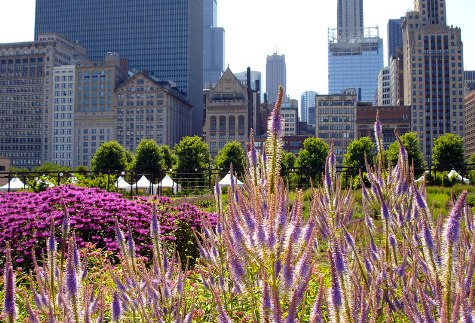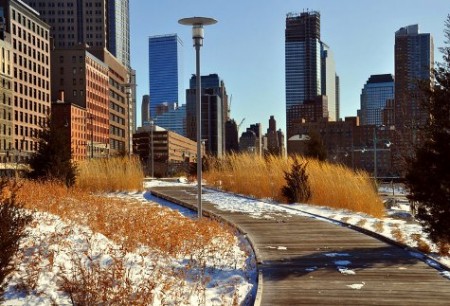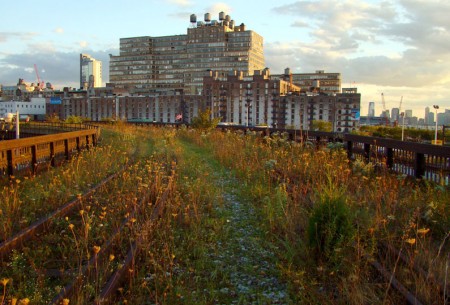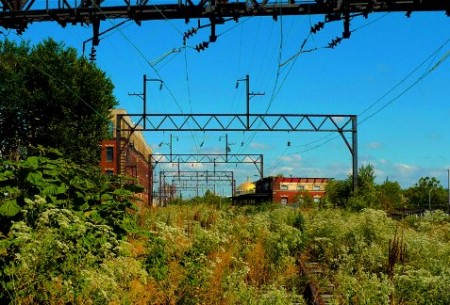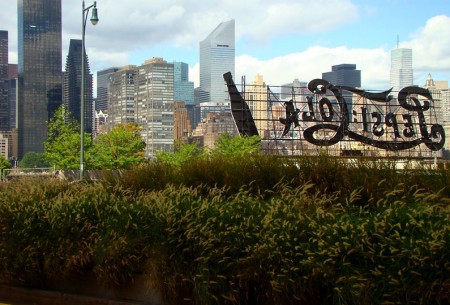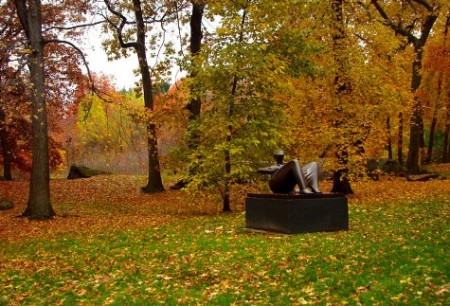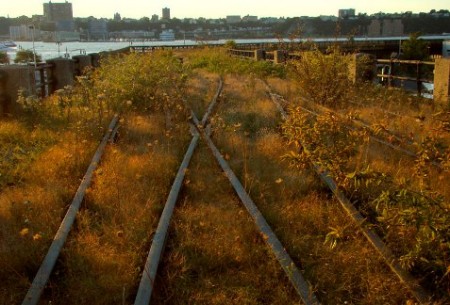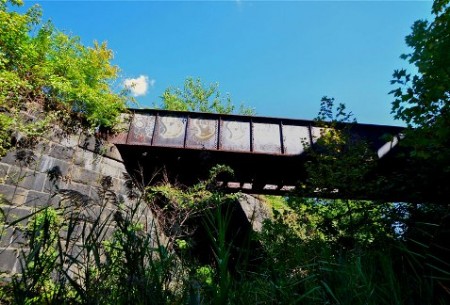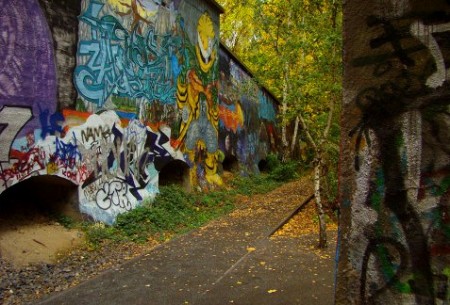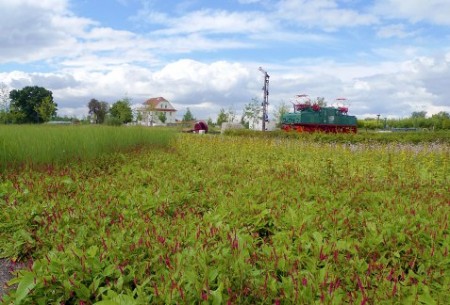In the past few years since I first heard about VIADUCTgreene, it has gone from being a nascent organization with hopes of developing Philadelphia’s own version of The High Line to a pulsating, vibrant not for profit that is going to change the landscape of Philadelphia~ transforming it from being a terrific city into an extraordinary one.
Paul vanMeter is the visionary and force behind VIADUCTgreene. His love of gardening and history and his knowledge of garden making combined with what he experienced when walking the unused Philadelphia railroad tracks proved to be the perfect ingredients for him to give birth to what will be a garden like no other in Philadelphia and surrounding areas.
A few words about Paul – He is a landscape gardener whose work ranges from intimate private to expansive public places. His passionate interests and lifelong studies of urbanism, landscape design, ethics and management, railroad history and culture have collided in his co-founding of VIADUCTgreene. – Fran Sorin
Can you describe what VIADUCTgreene is?
VIADUCTgreene creates a garden of intersecting culture and wildness along the soaring and submersive landscape infrastructures that are the Philadelphia and Reading Railroad 9th Street and City Branches.
VIADUCTgreene (VG) advocates for the creation of a linear gardenpark in Philadelphia along the former 9th Street Branch and City Branch of the Philadelphia & Reading Railroad.
What was your inspiration for it?
So many wonderful postindustrial places turned garden! From the Crowinshield Garden built over the ruins of the DuPont Powder works at Elutherian Mills in Delaware to the Bridge of Flowers in Shelburne Falls, Mass to Natur Park Südgelände in Berlin, Landschaftspark Duisburg-Nord, also in Germany, the Promenade Plantée/Viaduc des Arts in Paris. I guess it nearly goes without saying the High Line in New York. Friends of the High Line, organizationally especially, has been tremendously inspiring.
What ignited the fire in you to take it from a ‘maybe concept’ to ‘let’s do it’?
Spending time with Robert Hammond, co-founder of Friends of the High Line. He said for quite a while he and Josh David were two guys, a good logo, and a good idea. Friends of the High Line sponsored an International Ideas Competition in January 2003. It’s 2013 and while never being part of a neighborhood, city, parks department, or any other plan the place has not only been built, it’s become iconic. Big Idea.Ten years. Incredible.
Why did you choose the name VIADUCTgreene?
VIADUCTgreene. One word. In Philadelphia, the common name for the elevated 9th Street Branch is the Reading Viaduct. Being from Reading, Pa. that doesn’t make sense, where there are a few Reading viaducts. It’s the same with upstate Pennsylvania where every other valley has a Reading Viaduct! Internationally, it gets all the more confusing. Piet Oudolf’s recent book includes a picture of Macleaya cordata on the “Reading, Pa viaduct,” but it’s taken in Philadelphia. There was no getting away from “VIADUCT.” As a gardener, I’ve always enjoyed the word green on many levels, but especially WEBSTER’s 4:a : a common or park in the center of a town or village. The superfluous e kipes Olde English and William Penn’s utopian view of his city plan for Philadelphia, more attuned to his love of country estates than metropolis. “Let every house be placed… so that there may be ground on each side for garden or orchard, or fields, that it may be a greene countrie towne, which will never be burnt and always wholesome.”
Names and nomenclature are important. I can’t imagine the High Line called the West Side Improvement Park or Promenade Plantee the Paris-Bastille to Boissy-St Leger Park. The Promenade Plantée was inspiring so far as naming. Bringing it back to a Philadelphia thing, the area was once estates. William Penn’s and heirs owned Springettsburry, later Alexander Hamilton’s Bush Hill occupied locations where the museums are and the City Branch traverses. The railroads came along in the early 1830s.
How many blocks is the project going to be?
Depending on who’s counting, 55-58 blocks. Three miles without crossing a street.
It’s not all above ground ~ and it crosses different sections of the city. Can you explain how the feel of the different neighborhoods and the logistics of the tracks play into creating the garden? What areas will it traverse?
The former City Branch is over two miles long and sub-grade. It’s mostly wide open to the sky except for a 3000’ long “tunnel” beneath Pennsylvania Avenue which has stunning brick arches. The whole of the City Branch is enclosed by massive stone walls, from a foot high to over 30’ high. Just about the entire right-of-way (ROW) was minimally a four-track railroad, over 50’ wide. Today it’s easy to vision separated places for bicyclists and pedestrians and art and garden. Lots of garden; it’s all a garden.
There are a variety of neighborhoods. At the far west and north is Brewerytown/Fairmount, all very residential. The Museum District includes the Philadelphia Museum of Art with its amazing annex art-deco Ruth and Raymond G.Perelman Building, the Rodin Museum, and of course, the recent move of Barnes Foundation collection to its stunning Tod Williams Billie Tsien building is one of the art worlds’ greatest stories, and always will be.
Logan Square is a vivid mix of the museums, residents and cool commercial establishments. The ROW adjoins the Community College of Philadelphia and its thousands of students and continues beneath North Broad Street, arguably the most happening place in the city as the North Broad Street ‘Avenue of the Arts’ initiative designs its way from City Hall to Temple University. Above North 13th Street, submersive becomes soaring as the City Branch meets the 9th Street Branch at Callowhill Junction. Authenticity is palpable in the Callowhill/Chinatown North communities; the city’s work toward managing ‘gentilfication’ will be vitally important to maintaining the distinct and delightful character. The east end is North of Spring Garden Street, becoming a attractive link in the East Coast Greenway. It’s about gardening; cultivating what’s there. The unique qualities of the neighborhoods enroute make for a great site.
What type of planting ~gardens do you envision? Will it be a continuous theme throughout?
I believe the best place projects, whether strictly architectural, landscape or a combination, have a very powerful unifying character. The High Line is a great example. However one feels about the details, the overall theme-powerfully and simplistically designed paving and constructed details contrasted with a planting design inspiring a certain “wildness” is popular beyond belief. That’s what I envision; but, who knows? I think an Ideas Competition is obligatory for such a great site. It’s exciting to see and hear about what people think!
Philadelphia is a bastion of horticulture with a rich history. Do you think that VIADUCTgreene will offer a new type of garden for the city and surrounding areas? How do you envision it to be uniquely Philadelphia?
A great knowing and respect for that rich planterly and planning history is a big motivating factor in my advocacy. It’s humbling. Along with sponsoring an International Ideas Competition that focuses on the 3-mile continuity and the possible connections, one directed goal of VG is to sponsor a symposium, called the Spontaneous Garden, or something like that. As a gardener, or an urbanist, experiencing and studying places like Natur Park Südgelände in Berlin, the Landschaftspark in Duisburg and other Rhur Valley places changes your game. Projects based on the traditions of the Enlightenment and industrial modernism in the Wörlitz Garden Realm coming from the Bauhaus Dessau Foundation in “The Industrial Garden Realm” are truly inspiring. Largely, the spontaneous vegetation is intelligently managed with important and subtle introductions.
Walking along the Philadelphia ROW with so many people, it seems everybody notes the beauty of the place that currently exists. With so much of the site at grade, or in the case of the 9th Street Branch, built on fill between stone and concrete walls, being inspired by it directly is certainly a conversation worth having. It also plays on the new movements about tree planting -plant xthousand trees! A lot of good minds I know are thinking simply- maintain xthousand trees! Robinia and Paulownia are my friends.
I think a symposium would be very popular with a lot of land managers looking for answers to creating, highlighting, and managing a certain level of wildness.
Do you think it will change how visitors experience Philadelphia
Another great motivator is Philadelphia’s industrial heritage. For a long time, the city has, importantly and charmingly, been happily wearing a tricorned hat mode. In the 18th century Philadelphia founded the country, in the 19th and 20th it industrialized it and the entire world with it. The City Branch ROW served a bustling industrial corridor that included the Baldwin Locomotive Works. In 1906 Baldwin built 2,666 locomotives, more than seven every day, all of them right at North Broad and Spring Garden Streets, where it employed 17,400 men. “At the turn of the 20th century, Baldwin’s “climbed Pikes Peak, hauled the Trans-Siberian Express, roamed the Argentine Pampas and whistled past the Egyptian pyramids!
The site itself is book ended by Philadelphia’s pioneering c.1830 railways. That the rights-of-way are still intact and moribund is a great story in and of itself.
That history is palpable along the corridor and we seem to be in a time where, warts from the hubris of it and all, people are interested. That and the idea of ruin and regeneration make for a lot of stories to tell. That the site offers undercover spaces for programming makes it attractive to tell those stories. There have been a lot of tours over the site; it’s absolutely changing how people experience the city.
It took the founders of The High Line several years to get their project off the ground and running. What is the #1 obstacle that if removed could move the project forward at lightning speed?
Awareness. The site, its connectivity and desirability isn’t the least bit obvious – just like almost every great garden place I know!
In your dreams, how do you envision VIADUCTgreene to be/look in 5 years?
Like dreams, VIADUCTgreene is part of the realm of ideas. For now, what’s important is preserving the right to develop the most creative results possible while acknowledging that not knowing the outcome at the outset is not only okay, it’s also better.
In five years – a place civically, physically visioned and in- part being constructed.
What’s the most important thing you’ve learned from working on VIADUCTgreene these past few years?
Every action the least bit provocative has political challenges. I think it’s important to work on an agenda of directed goals. If people are uncomfortable, move on from those people. Allow people to dream.
**If you enjoyed this article, please share with your friends on Facebook, twitter, and other social media.

